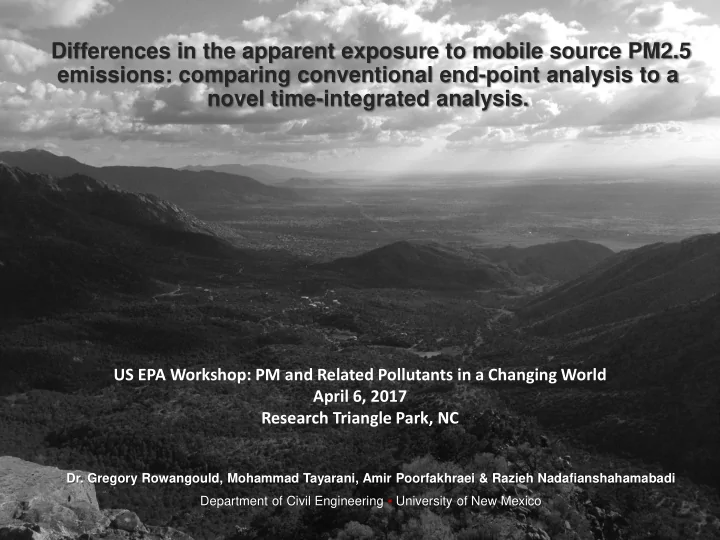

Differences in the apparent exposure to mobile source PM2.5 emissions: comparing conventional end-point analysis to a novel time-integrated analysis. US EPA Workshop: PM and Related Pollutants in a Changing World April 6, 2017 Research Triangle Park, NC Dr. Gregory Rowangould, Mohammad Tayarani, Amir Poorfakhraei & Razieh Nadafianshahamabadi Department of Civil Engineering ▪ University of New Mexico
Research Aims • How do changes in land-use, transportation systems, and related policies affect: • Exposure to PM2.5 emissions from vehicle exhaust over time and space? • Mobile source GHG emissions over time? • Which strategies and policies can minimize PM2.5 exposure, PM2.5 exposure inequities, and GHG emissions throughout the entire planning horizon?
Exposure & Environmental Justice Figure from Rowangould, G. (2013). A Census of the United States Near-Roadway Population: Public Health and Environmental Justice Considerations. Transportation Research Part D: Transport and Environment . 25pp. 59-67
Land Use and Vehicle Emissions Increasing density & mix of land uses: - Lower vehicle miles traveled - Less vehicle mode share - Lower emission inventories - Fewer GHGs - Air quality & Exposure???
Part 1 Modeling Changes Through a Planning Horizon
State of the practice…
Transportation and Land Use Scenarios Trend Scenario Expects Continuing development trends • • No new transit infrastructure • Mostly peripheral housing development while employment remains more centrally located. Preferred Scenario Encourages New development in existing activity centers • • New development near transit corridors (TOD) • Greater land use mix • Less development in flood and fire risk areas • New investments in transit
Results: Central New Mexico Climate Change Scenario Planning Study Trend Preferred Constrained 40% 36% 34% 33% 31% 27% 30% 23% 23% 19% 18% Chnage from 2012 Baseline 20% 10% 0% -2% -10% -7% -8% -12% -20% -19% -19% -30% -28% -31% -40% -37% -50% Land Averge Peak VMT/Capita River Crossings GHG Emissions GHG/Capita Developed Hour Speed
Modeling Approach Land-Use Model (Urbanism) Parcel Location: iterate at each time period Trip Generation Households Employment Trip Distribution Mode Choice Highway Conditions: Route Choice - Link traffic volume - Link average speed Emission Model Air quality Model Exposure Model (AERMOD) (MOVES) Population Exposure Levels
Air Quality Modeling Vehicle Emission Rates: US EPA MOVES model • • Air Quality: US EPA AERMOD model • Apply a unique rastering approach to more quickly model a large urban area. 1 1 Rowangould, G. M. A new approach for evaluating regional exposure to particulate matter emissions from motor vehicles. Transportation Research Part D: Transport and Environment , Vol. 34, Jan. 2015, pp. 307–317.
Albuquerque: PM2.5 Concentration
Albuquerque: Change in GHGs 2012-2040 12,400 600 Annual GHG Annual VMT 29 End Point GHG End Point VMT 12,200 GHG Emission Factor 500 Daily Vehicle Miles Traveled (Millions) 27 12,000 GHG Emissions (tonn/day) GHG Emission Rate (g/mi) 400 11,800 25 300 11,600 23 200 11,400 21 100 11,200 11,000 0 19 2012 2017 2022 2027 2032 2037 2012 2017 2022 2027 2032 2037 Year Year
Albuquerque: Change in PM2.5 2012-2040 600 0.040 Annual PM2.5 Annual VMT 29 0.035 End Point VMT End Point PM2.5 500 PM2.5 Emission Factor Daily Vehicle Miles Traveled (Millions) 0.030 27 PM2.5 Emission Rate (g/mi) PM2.5 Emissions (kg/day) 400 0.025 25 300 0.020 0.015 23 200 0.010 21 100 0.005 0 0.000 19 2012 2017 2022 2027 2032 2037 2012 2017 2022 2027 2032 2037 Year Year
Land-Use Change 2012-2040
Land-Use: End-point vs. Annual Modeling Approach 25000 20000 Population Density (persons/mile 2 ) 15000 10000 5000 0 2012 2017 2022 2027 2032 2037 Year
Part 2 Dynamic Exposure
Atlanta: Dynamic Exposure Analysis
Atlanta: Preliminary & Partial Results Dynamic Static 6.00 Mean Daily PM2.5 Exposure (µg/m3) 5.00 4.00 3.00 2.00 1.00 0.00 Occupation
Atlanta: Preliminary & Partial Results Dynamic Static Dynamic Static 5.00 6.00 4.50 Mean Daily PM2.5 Exposure (µg/m3) Mean Daily PM2.5 Exposure (µg/m3) 5.00 4.00 3.50 4.00 3.00 2.50 3.00 2.00 2.00 1.50 1.00 1.00 0.50 0.00 0.00 < 20 20 - 40 40 - 60 > 60 Age Median Household Income
Atlanta: Preliminary & Partial Results 5 4.5 Mean PM2.5 Exposure ( µ g/m 3 ) 4 3.5 3 2.5 2 1.5 1 0.5 0 < 5 5 - 10 10 - 15 15 -20 20 - 25 > 25 % of Exposure During Commute
Next Steps • Albuquerque • Model exposure over planning horizon • Develop and model a wide range of land-use and transportation strategies • Identify strategies that minimize PM2.5 exposure, GHG emissions and inequality over the entire planning horizon • Atlanta • Model individual level exposure through planning horizon • Evaluate factors associated with different levels of exposure • Evaluate environmental justice • Both Regions • How do these advanced methods differ from current air quality analysis requirements and practice?
Acknowledgments This research has been supported by a grant from the U.S. Environmental Protection Agency's Science to Achieve Results (STAR) program (grant # 83588501 ).
Recommend
More recommend